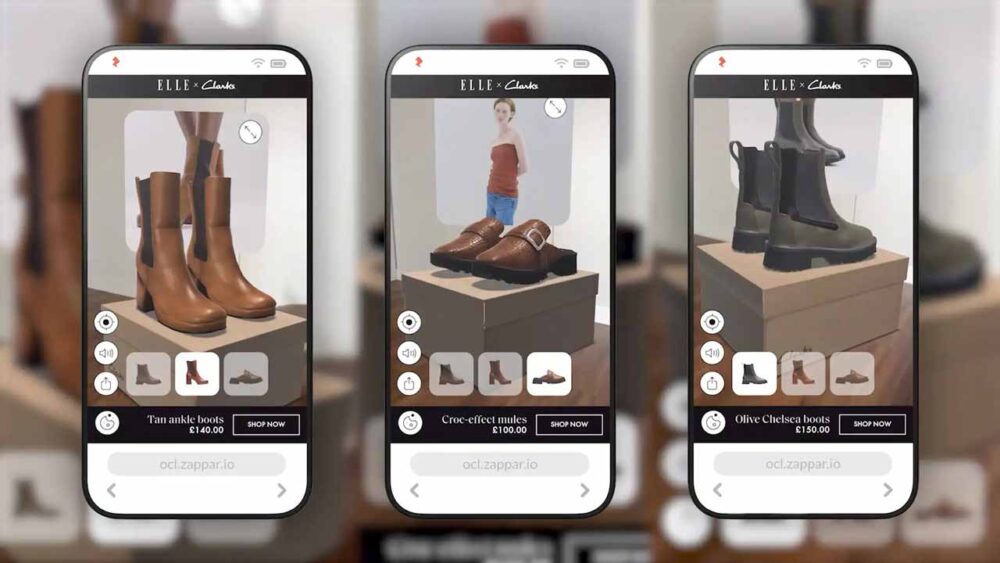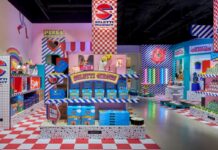Retailers and marketers are looking for ways to enhance consumer engagement, drive sales and foster longer-term brand loyalty. In crowded and competitive markets, marketing leaders need to find creative ways to make their products stand out while increasing buying propensity. Engaging with shoppers wherever they are with more dynamic, fun, and playful experiences is helping many businesses do just that.
Retailers across a range of markets including fashion, beauty, and FMCG are exploring how digital experiences can enhance shopping and e-commerce consumer journeys. Whether you’re launching a new pop-up, e-commerce activation, social media campaign, or looking to re-imagine in-store experiences, immersive technology and interactive experiences can help spotlight your brand and drive deeper consumer engagement.

Connect with consumers through augmented reality (AR) innovation
Harnessing augmented reality (AR) as part of a retail activation is becoming an increasingly popular way for marketers to create memorable experiences that boost sales and foster longer-term brand engagement. AR activations are relatively simple for brands to deploy and are widely accessible for almost any consumer with their mobile device — eMarketer predicts that by 2025, over 100 million people will use AR every month in the USA. AR has been around for some time already, with brands like IKEA, Wayfair, Target, John Lewis and many more using 3D design and AR to help customers visualise products in their own home – if you’re renovating or thinking about replacing an item of furniture and you’re not using AR to try-before-you-buy, you’re missing out.
Plenty of marketers are deploying fun AR experiences as an element of high street or in-venue pop-ups to create physically engaging and memorable experiences that add more colour and brand narrative to a regular shopping journey. In the e-commerce space, AR can also have a massive impact on shopper engagement. Accurate and dynamic product visualisations in 3D via web-based experiences give users a much better feel for the products they are browsing — especially when using smart ‘try-on’ tools to see how a pair of shoes would look on their own feet. With expectations closer matched to reality, outlets can reduce return rates and elevate shopper satisfaction.
Accessibility is also a game-changer — these types of experiences can be universally accessible to anyone with a mobile device and easily distributed via QR code displays or digital URL links. Taking the shopping experience directly to any consumer – whether they’re on the go or in their living room – and backing it up with fun and interactive functionality, is proven to help drive purchase rates and brand engagement.
How ELLE Magazine and Clarks brought the catwalk to life
We recently partnered with content and media company Hearst UK to launch a new creative e-commerce for ELLE Magazine and Clarks — illustrating how brands can use AR to engage with consumers. By scanning a QR code on magazine copies or clicking a link on social media, users can instantly browse and visualise the latest Clarks collection in 3D, with catwalk clips, styling tips, and a link to direct purchase — all via their mobile device from wherever they are. Thousands of ELLE readers have already explored the experience so far.

These types of activations are now quicker and easier than ever for brands and marketers to run. In as little as a couple of weeks, creative agencies with deep extended reality (XR) expertise like ARCADE can model and animate 3D assets, create all the additional 2D and user interface elements, and then develop the experience on web-based AR platforms such as Zappar, 8th Wall or Snap that are simple and easy for consumers to enjoy.
Cut through the hype to drive genuine impact
In the tech-hype lifecycle, marketers have moved beyond the ‘new shiny thing’ stage from a few years ago with AR. We’re past AR’s infancy where brands could use the novelty of ‘now with augmented reality!’ to grab consumers’ attention. AR activations are increasingly commonplace which, counterintuitively to ‘next-big-thing’ marketers, is a positive. It means audiences are beginning to understand and even expect spatial experiences, so we no longer have to shout about AR for AR’s sake — we can simply let it do its thing as part of a purposeful campaign.
AR might not always be the perfect solution or the right fit for every circumstance. But if you want to make a shopper feel more connected to your brand in the space they are in, if you want to foster a genuine sense of proximity, and if you want to give your consumer a magic ability to inspire an emotional response that 2D media struggles to achieve, then spatial experiences can be incredibly powerful. The key is to recognise AR for what it is: not an end in itself, but a medium just like any other, albeit one that makes new forms of experience possible — and therefore, new ways to foster emotional engagement with consumers.
Emotion drives brand engagement
Retailers shouldn’t be expected to care about AR or any other disruptive technologies for their own sake. Every marketer knows that engagement comes from emotion — feeling something that changes or reinforces your relationship with the brand delivering the experience.
AR – and indeed all forms of extended reality – are unlocking new and creative ways for brands and retailers to engage with consumers, supporting immediate sales efforts and building meaningful connections. Even the most practical of AR applications, such as furniture visualisation, can have a huge effect on brand equity, bolstering perceptions around innovation, trust, relevance and empathy. A brand that is willing to invest in tools that make life easier – and more enjoyable – is a brand shoppers want to keep in their lives.

Alex Book, Co-founder & Chief Strategy Officer, ARCADE
Alex Book is Co-Founder and Chief Strategy Officer at ARCADE, an international digital experience practice specialising in AI and XR technologies for a variety of sectors including brands & marketing, sports & entertainment, and arts & culture.















